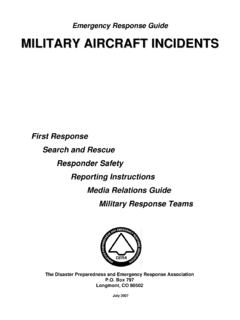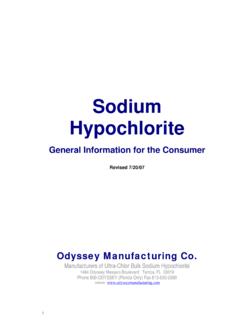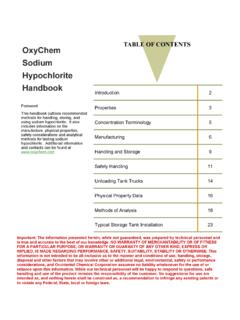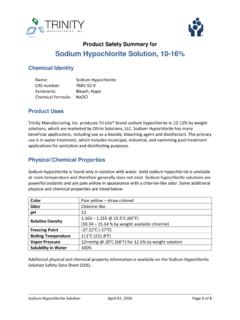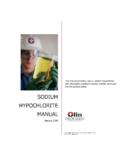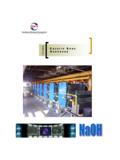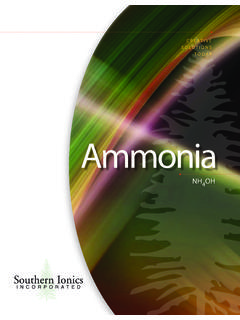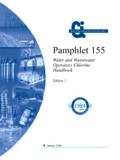Transcription of Emergency Biological Decontamination Solutions - …
1 Emergency Biological Decontamination Solutions By Robert J. Heyer, During times of biohazard Emergency large amounts of sewage and other Biological contaminants will present heath issues. Sewerage, rotting foods, animal carcasses, and human remains can all pose a health risk to responders. Large-scale Decontamination methods will be required. Different Solutions can be used to decontaminate property and persons exposed to Biological contaminates. The information presented here is for academic consideration and the author assumes no liability or responsibility for its use. Bleach Solutions - Liquid bleach solution works well as a general Biological Decontamination solution for equipment and property.
2 The problem is it does not provide large qualities of solution. Straight out of the bottle liquid bleach is in an approximately 5% concentration. An effective solution can be prepared my mixing one part of liquid bleach with nine parts of water. This will make an approximately solution. The solution can be applied by commercial sprayer, bottle sprayer, or brushed on. It is important to leave the solution on and for a time to allow the proper amount of contact time. It takes time for the solution to kill viruses and spores so give it plenty of contact time before removing with fresh water.
3 The Decontamination of living persons should not use straight liquid bleach. Most authorities recommend the bleach solution for use on skin. Never let the solution come in contact with eyes. Never mix bleach with ammonia as a very dangerous gas may be produced. For Decontamination of property such as glasses and jewelry use a 5% bleach solution. Make sure with any bleach solution that it is allowed to sit for at least fifteen minutes before it is removed. This contact time is necessary to kill the germs and spores. Larger quantities of bleach Solutions can best prepared using commercial pool products.
4 Follow the directions on the individual products for mixing. In no instructions is available mix a 25 Lb. pail of calcium hypochlorite to about 60 gallons of water to give you an approximately 4% bleach solution. Like with liquid bleach allow proper contact time. Soap and Water- Soap and water makes a good personal Decontamination . Washing with copious amounts of hot soapy water will remove most Biological contaminates from Emergency responders who have been exposed to contaminated water. Soap and water is about the only material that can be used on the eyes. It will be painful but they eyes can be washed with soap and water followed by flushing with large amounts of clean water.
5 As always it is important to seek medical advice before starting any Decontamination procedures on living people or animals. Alcohol- Alcohol Solutions can be used to decontaminate hard non-porous surfaces and personal property. 70% alcohol Solutions will be effective on most Biological contaminates. The major drawback is that alcohol is flammable and explosive. It should never be used where there is open flame or spark. Small superficial cuts can be decontaminated with 70% ethyl or isopropyl alcohol followed by flushing with clean water. Don t use on deep wounds without guidance from medical personal.
6 Personal Decontamination - If possible, the very best thing you can do is taking a long soapy shower in warm water. Before you enter any structure remove as much of your outer clothing as possible and your shoes. Be sure to shower in warm water using plenty of soap. Wash your hair with detergent shampoo and scrub head to toe, starting at your head and working to your feet. If a Decontamination team is available they will decontaminate you on the scene. If none of the above is available, remove as much outer clothing as possible and rinse with copious amounts of water. A Decontamination solution can be made from common liquid bleach.
7 Use one part of bleach out of the bottle to nine parts of water. This can be used on all parts of the body except your face. Keep bleach well away from your eyes. Remember never to mix with ammonia as a poisonous gas can result. Be sure to allow the bleach solution to remain in contact with your skin and clothes for fifteen minutes to allow time to kill any Biological agents on you. Equipment Decontamination - To decontaminate your equipment use full strength bleach. Bleach right out of the bottle should be 5% sodium hypochlorite in strength. Wipe or spray the solution over large equipment.
8 Soak smaller equipment in a bucket filled with bleach. Allow at least a half hour of contact time before flushing with fresh water. With all Decontamination of Biological agents it is very important to allow proper contact time to kill the agent and its spores. If you use a solution other than bleach to decontaminate be sure to read the instructions for a proper contact time. Decontamination Stations Recommendations Locate the station upwind of the hazard. Set up a windsock to monitor wind shifts. Use protective clothing for team members. Contain all run-off generated.
9 Enclose and heat the station in below freezing temperatures. Have police at station to maintain order. Cover entire ground with tarps if possible. Keep records of all people decontaminated. Have separate men and woman's stations when possible. Send to medical evaluation team. Basic Supplies Pre-formed children's pools. Brushes. Laundry soap. Tarps. Wash tubs. Liquid bleach. Protective clothing. Disposable gowns. Garbage bags. Notebook and pen. Chemical handbooks. Garden hoses and hose wands. Spray bottles. Blankets. General Decontamination Procedure 1.
10 Remove visible signs of contamination by physical means such as scraping, blotting, or brushing it off. 2. Remove jewelry, contact lenses or glasses from the victim and bag for Decontamination . 3. Carefully remove the victim's clothing by pulling it away from the victim's body. Never remove anything over the head; cut it away instead. 4. Wash the face and hands of the victim. Use warm water and soap if available. 5. Starting at the neck and working down, decontaminate the victim's body. Use soap and water if available and have them lather as you rinse with water. 6. Give clean clothing to the victim.
